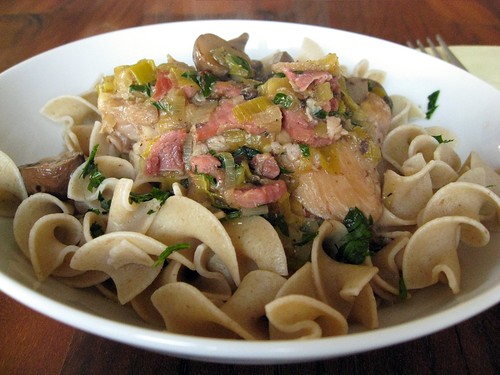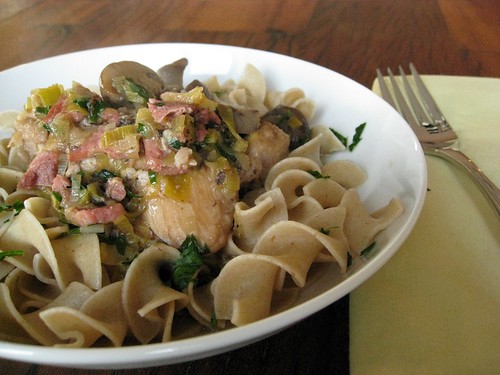Coq au Riesling
05
I’m a big time red wine drinker, but I’m not as big of a fan of whites. I also don’t like overly fruity varietals, like Riesling. They are just way too sweet for my liking. But, I did get a bottle gifted to me and it’s been sitting in the bar, taking up precious alcohol space (according to my husband), so it needed to be used. I was a little nervous about using it in a recipe, especially one for coq au Riesling where it is the dominant ingredient. The flavor of wine concentrates as it cooks, and I was worried I’d end up with a pot of overly sweet chicken. But, my fears were totally unsubstantiated. This comforting dish had just a little bit of sweetness, and combined with the other ingredients (and the pasta, of course), it was really quite comforting.
Nigella doesn’t really specify whether you should use bone-in chicken thighs, but I did for two reasons: 1. frugality (much cheaper to buy bone-in and then skin yourself) and 2. taste. The bones add so much more flavor to the stewing liquid than just the meat would. Now, this obviously leaves you with bones to deal with in the final product, but since this simmers for an hour, the chicken just shreds effortlessly. You can either shred it and add it back to the pot, or you can just put a whole chicken thigh or two per plate (which is what we did).
I halved the original recipe and made a few other changes, based on what I had around. The entire recipe is supposed to make 6 servings, but we got 6 from the halved serving (1 thigh per person, plus egg noodles). It will just depend on your appetite, your typical portion size, and what you serve with it (roasted asparagus and the aforementioned whole wheat egg noodles for us).

Coq au Riesling
3 thick slices of bacon, chopped
6 chicken thighs, bone-in and skin off
1 leek, sliced
2 cloves garlic, minced
5 oz. cremini mushrooms, cut in half
2 bay leaves
1/2 bottle Riesling
3 Tbsp. chopped parsley
Heat a dutch oven over medium heat, and then add the bacon. Cook until bacon is slightly crispy and then remove with a slotted spoon. If there’s too much fat left in the pan, drain off some of it. Sprinkle the chicken with salt and pepper and then add to the hot pan, browning for a couple minutes per side. Remove. Add the leek and cook until softened.
Deglaze the pan with the Riesling, and then add the chicken and bacon back in, as well as the mushrooms, bay leaves, and salt and pepper to taste. Bring to a boil, cover, and then reduce to a simmer for one hour.
Season to taste and add the chopped parsley before serving.
Adapted from Nigella Lawson
I don’t like Riesling either. I prefer a nice Pinot Noir. However, this looks really good! Maybe I’ll buy a cheap bottle and give this a try.
P.S. Thanks for the birthday wishes!
Sounds great! Thanks for sending it to the event!
I actually think I would prefer this to traditional Coq au Vin! I like the sweeter white wines.
Hi Elly, my father and his parents were from Alsace, France. Coq au Riesling is actually a recipe originating in Alsace. Riesling from this region is DRY, never sweet. Being that you don’t care for sweet wines, I suggest you try this recipe with either an Alsatian Riesling, (if you can find it) or simply an off dry wine such as Clos Du Bois Riesling (California). In fact, to cook this recipe with a sweet Riesling is completely wrong (although still quite tasty!). The authentic recipe also uses a whole rooster, cut French-style and bone-in, skin on. French-style is where you are left with 8 pieces of chicken: 2 thighs, 2 legs, 2 half breasts with wings attached and 2 half breasts (so you would cut the breasts crosswise, leaving the wing on one half). Of course, where can you find a rooster?! So, I just use a 4 lb hen found at the local grocery.
Coq au Rielsing is a classic dish of Alsace in eastern France where is Riesling wine is fermented to dryness. This style of Riesling is crisp, bone bry and very aromatic when it is ripe and a bit leaner when the vintage is lighter. Both style are delicious with the cuisine of Alsace. These wines also age very well with some comparable to white Burgundy in aging potential. Many Americans miss the mark with Riesling as they have the idea that it is a beginner’s wine or anything sweet must be neophyte. The Alsatian ones are not sweet and some of the German Rieslings are great wines despite being slightly sweet to very sweet.